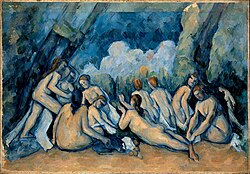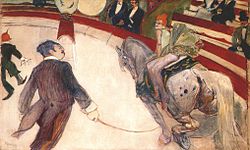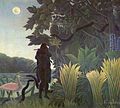
Post-impressionism (or Post-Impressionism) is a term used to describe the development of French art after Manet (1832–1883).
The British artist and art critic Roger Fry used the term in 1910, and it is now a standard art term.[1][2] Fry organized the 1910 exhibition Manet and the Post-Impressionists.
The post-impressionists were artists of the late 19th century who saw the work of the French Impressionist painters and were influenced by them. Their art styles grew out of the style called Impressionism. The word "Post-" means "after", so "post-impressionist" painting came after "impressionist" painting. These artists developed impressionism but rejected its limitations. They continued using the real-life subject matter, with vivid colours, often with thick paint. However, they added other ideas. Using geometric forms, to distorting form for effect, and using unnatural colours are some of their ways. The critic Rewald said "the term 'post-impressionism' is not a very precise one, though a very convenient one".[3]
The main post-impressionist painters were Paul Cezanne, Paul Gauguin, Vincent van Gogh, Georges Seurat, Henri Toulouse-Lautrec and Henri Rousseau ('Le Douanier'). Picasso and Braque were certainly post-impressionists, but we describe them as Cubists.[4]
The post-impressionist painters lived in France and knew each other, but they did not work together as a group, in the way that some of the impressionists did. They painted in ways that were different from each other. The post-impressionists led the way for other artists to experiment and develop all the different styles of Modern art in the 20th century.













